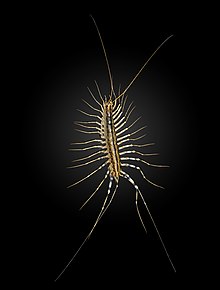Scutigera
Appearance
| Scutigera Temporal range: Eocene to present
| |
|---|---|

| |
| Scutigera coleoptrata, the house centipede | |
| Scientific classification | |
| Domain: | Eukaryota |
| Kingdom: | Animalia |
| Phylum: | Arthropoda |
| Subphylum: | Myriapoda |
| Class: | Chilopoda |
| Order: | Scutigeromorpha |
| Family: | Scutigeridae |
| Genus: | Scutigera Lamarck, 1801 |
| Type species | |
| Scutigera coleoptrata Linnaeus, 1758, by original designation.
| |
| Species | |
|
See text | |
| Synonyms | |
| |
Scutigera is a centipede genus in the family Scutigeridae.
Member of the genus have pseudofaceted eyes. This type of eye consists of a cluster of numerous ocelli on each side of the head, organised in a way that resembles a true compound eye, a type of eye found in arthropods. Most myriapods bear stemmata - that is, single lensed eyes which evolved by the reduction of a compound eye. However, the genus Scutigera has secondarily re-evolved a compound eye composed of repeated stemmata.[1] These appear to grow in rows which are inserted between existing rows of ocelli.
Species
Extant species
- Scutigera aethiopica
- Scutigera argentina
- Scutigera asiatica
- Scutigera buda
- Scutigera carrizala
- Scutigera chichivaca
- Scutigera coleoptrata
- Scutigera complanata
- Scutigera dubia
- Scutigera fissiloba
- Scutigera flavistoma
- Scutigera hispida
- Scutigera linceci
- Scutigera longitarsis
- Scutigera marmorea
- Scutigera melanostoma
- Scutigera nossibei
- Scutigera oweni
- Scutigera oxypyga
- Scutigera parcespinosa
- Scutigera planiceps
- Scutigera poicila
- Scutigera rubrilineata
- Scutigera sanguinea
- Scutigera sinuata
- Scutigera smithii
- Scutigera tancitarona
- Scutigera tonsoris
- Scutigera virescens
- Scutigera voeltzkowi
Fossil species
- Scutigera illigeri, Eocene of Poland (Baltic amber)[2]
- Scutigera leachi, Eocene of Poland (Baltic amber)[2]
References
- ^ Paulus, H.F. (2000), "Phylogeny of the Myriapoda-Crustacea-Insecta: a new attempt using photoreceptor structure*", Journal of Zoological Systematics & Evolutionary Research, 38 (3): 189–208, doi:10.1046/j.1439-0469.2000.383152.x
- ^ a b "Fossilworks: Scutigera". fossilworks.org. Retrieved 2020-12-15.
- Lamarck J.-B., 1801. "Système des animaux sans vertebres". Paris, Deterville VIII + 432 pp., see p. 182.
- Würmli, M., 1977. "Zur Systematik der Gattung Scutigera (Chilopoda: Scutigeridae)". Abhandlungen und Verhandlungen des Naturwissenschaftlichen Vereins in Hamburg N.F. 20: 123-131, see p. 123.
External links
